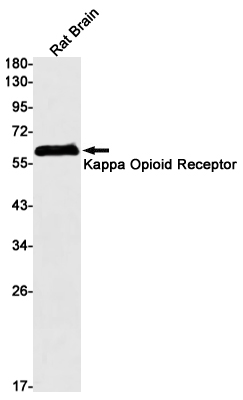-
Product Name
Anti-Kappa Opioid Receptor Rabbit antibody
- Documents
-
Description
Kappa Opioid Receptor Rabbit monoclonal antibody
-
Tested applications
WB, IHC-P, IP
-
Species reactivity
Mouse, Rat
-
Alternative names
KOR; R21; KOR-1; MSL-1; Oprk2; K-OR-1 antibody
-
Isotype
Rabbit IgG
-
Preparation
Antigen: A synthetic peptide of mouse Kappa Opioid Receptor
-
Clonality
Monoclonal
-
Formulation
Supplied in 50nM Tris-Glycine(pH 7.4), 0.15M Nacl, 40%Glycerol, 0.01% sodium azide and 0.05% BSA.
-
Storage instructions
Store at 4°C short term. Aliquot and store at -20°C long term. Avoid freeze / thaw cycle.
-
Applications
1:1000
1:20
1:20
-
Validations

Western blot detection of Kappa Opioid Receptor in Rat Brain lysates using Kappa Opioid Receptor Rabbit mAb(1:1000 diluted).Predicted band size:43kDa.Observed band size:60kDa.
-
Background
Swiss-Prot Acc.P33534.G-protein coupled opioid receptor that functions as receptor for endogenous alpha-neoendorphins and dynorphins, but has low affinity for beta-endorphins. Also functions as receptor for various synthetic opioids and for the psychoactive diterpene salvinorin A. Ligand binding causes a conformation change that triggers signaling via guanine nucleotide-binding proteins (G proteins) and modulates the activity of down-stream effectors, such as adenylate cyclase. Signaling leads to the inhibition of adenylate cyclase activity. Inhibits neurotransmitter release by reducing calcium ion currents and increasing potassium ion conductance. Plays a role in the perception of pain. Plays a role in mediating reduced physical activity upon treatment with synthetic opioids. Plays a role in the regulation of salivation in response to synthetic opioids. May play a role in arousal and regulation of autonomic and neuroendocrine functions.
Related Products / Services
Please note: All products are "FOR RESEARCH USE ONLY AND ARE NOT INTENDED FOR DIAGNOSTIC OR THERAPEUTIC USE"
